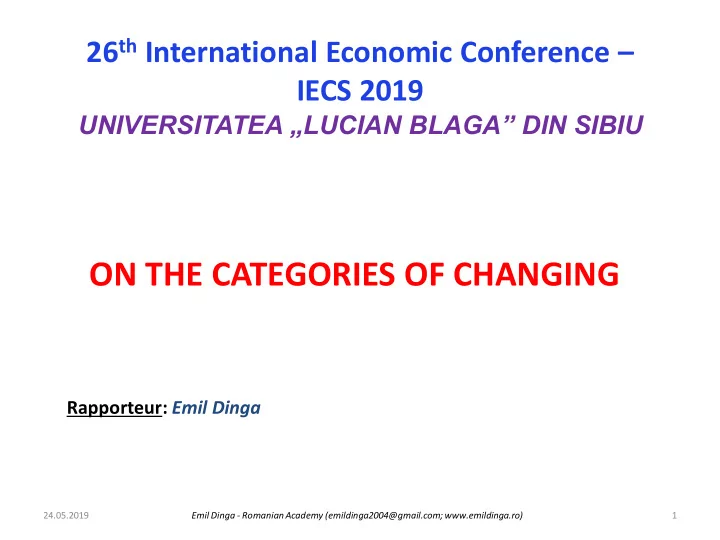

26 th International Economic Conference – IECS 2019 UNIVERSITATEA „LUCIAN BLAGA” DIN SIBIU ON THE CATEGORIES OF CHANGING Rapporteur: Emil Dinga 24.05.2019 Emil Dinga - Romanian Academy (emildinga2004@gmail.com; www.emildinga.ro) 1
CONTENTS • Identity vs . non-identity • Homogeneity vs . heterogeneity • Typology of identity • Changing as identity alteration 24.05.2019 Emil Dinga - Romanian Academy (emildinga2004@gmail.com; www.emildinga.ro) 2
IDENTITY VS. NON-IDENTITY (1/2) • (def) identity: a property of something (i.e. of a general entity, be it of substantial, informational, energy, or formal appearance) to overlap on itself, without rests, of any „generation” of the entity self -compared • sufficiency conditions to be observed an identity or a non-identity – a state vector : a clock time-indexed vector, which describes the definition parameters (of any kind) of the entity – a memory : a clock time- frozen state vector, i.e. a state vector that doesn’t change along the clock time – an overlapping procedure (or protocol): a procedure (available for the cognitive subject) to compare the state vector with the memory (i.e. the clock time-indexed state vector with the clock time-frozen state vector) 24.05.2019 Emil Dinga - Romanian Academy (emildinga2004@gmail.com; www.emildinga.ro) 3
IDENTITY VS. NON-IDENTITY (2/2) 24.05.2019 Emil Dinga - Romanian Academy (emildinga2004@gmail.com; www.emildinga.ro) 4
HOMOGENEITY VS . HETEROGENEITY (1/2) • (def) homogeneity: the state of an entity which conserves its identity • (def ) heterogeneity: the state of an entity which doesn’t conserve its identity • heterogeneization role: any change is the result of arising a heterogeneization inside an identity – NB: returning from non-identity to former identity implies also heterogeneization • homogeneity has no degrees, while heterogeneity has • a new homogeneity (i.e. a new identity) implies a heterogeneization phenomenon – so, the identity dynamics simply is a chain of heterogeneization phenomena • in fact, changing and its typopoly are given by the chain: identity – homonegeity – heterogeneization – re-homogeneization – identity – homogeneity ... 24.05.2019 Emil Dinga - Romanian Academy (emildinga2004@gmail.com; www.emildinga.ro) 5
HOMOGENEITY VS . HETEROGENEITY (2/2) 24.05.2019 Emil Dinga - Romanian Academy (emildinga2004@gmail.com; www.emildinga.ro) 6
TYPOLOGY OF IDENTITY (1/3) • remember the sufficiency predicates of a generic system: – a membrane ( 𝑵 ) (in my opinion, there are only three types of membranes: 1) physical membrane; 2) institutional membrane; 3) logical (i.e. cognitive) membrane • for example: a human being has a physical membrane, an economic organization has an institutional membrane, while a concept has a logical (i.e. cognitive) membrane. Of course, an empiric system could be characterized, concomitantly, by more than one type of the mentioned membranes.) • the membrane assures the discernibility between the system and its environment – a set of components ( 𝑭 ) (no matter their nature.): these components must be indiscernible among them at least for one attribute (parameter, characteristic) – a set of connections among the components ( 𝑮 ): these connections generate the functionality of the system; – a set of connections among the components and the environment ( 𝑪 ): these connections generate the behaviour of the system 24.05.2019 Emil Dinga - Romanian Academy (emildinga2004@gmail.com; www.emildinga.ro) 7
TYPOLOGY OF IDENTITY (2/3) 24.05.2019 Emil Dinga - Romanian Academy (emildinga2004@gmail.com; www.emildinga.ro) 8
TYPOLOGY OF IDENTITY (3/3) • based on the definition of a generic system, there are four tipes of identity: – 𝜷 individual identity: conservation (conservation is logically equivalent with non- 𝒋 ⋈ 𝑵 𝒖 𝒇 𝒋 alteration) of the 𝑵 𝑵 𝒖 𝒔 - the logical constant „ ⋈ ” means „identical”, i.e. equivalent from the point of view of membranes overlapping, in this case 𝒋 ⋈ 𝑪 𝒖 𝒇 – 𝒋 𝜸 species identity: conservation of the 𝑪 𝑪 𝒖 𝒔 𝒋 ⋈ 𝑮 𝒖 𝒇 𝒋 – 𝜹 genus identity: conservation of the 𝑮 𝑮 𝒖 𝒔 𝒋 ⋈ 𝑭 𝒖 𝒇 𝒋 – 𝜺 formal identity: conservation of the 𝑭 𝑭 𝒖 𝒔 NB: 𝒖 𝒔 is the moment of reference (the time-benchmark), and 𝒖 𝒇 is the moment of assessment regarding the identity state • by logically combining the four „atomic” identities, we can obtain other 11 cases of „molecular” identities, so there are 15 total types of identities: – 𝜷; 𝜸; 𝜹; 𝜺; 𝜷𝜸; 𝜷𝜹; 𝜷𝜺; 𝜸𝜹; 𝜸𝜺; 𝜹𝜺; 𝜷𝜸𝜹; 𝜷𝜸𝜺; 𝜷𝜹𝜺; 𝜸𝜹𝜺; 𝜷𝜸𝜹𝜺 24.05.2019 Emil Dinga - Romanian Academy (emildinga2004@gmail.com; www.emildinga.ro) 9
CHANGING AS ALTERITY ALTERATION (1/2) • understanding changing as identity alteration lead us to five distinct types of generic changing: – (C1) modification : alteration of the quantitative identity. The quantitative identity can be of two kinds: • (C1a) movement : is the kind of modification that alters the spatial identity (for example, the coordinates of the three dimensional space we currently experience in our Universe) • (C1b) growing : is the kind of modification that alters the size identity (it is very important to mention that the movement type of modification can generate effects on the growing type by simply space agglomeration (accumulation). For example, stars arising are, initially, an effect of pure movement and agglomeration of primordial matter. In the Figure 68 such a connection from movement to growing is included) – (C2) evolution : alteration of the qualitative identity (since the quality of a system is an effect of its structure, we can say also the evolution means the alteration of the structural identity. Because the causal relationship between the structure and the function, we can say also the evolution means the alteration of the system functioning. In order to assure a certain symmetry of the terminology, I preferred call this class of changing as alteration of the qualitative identity) – (C3) development : evolution generated by growing – (C4) transformation : evolution generated by purposes (goals) – (C5) progress : evolution generated by values 24.05.2019 Emil Dinga - Romanian Academy (emildinga2004@gmail.com; www.emildinga.ro) 10
CHANGING AS ALTERITY ALTERATION (2/2) 24.05.2019 Emil Dinga - Romanian Academy (emildinga2004@gmail.com; www.emildinga.ro) 11
THANK YOU FOR ATTENTION! 24.05.2019 Emil Dinga - Romanian Academy (emildinga2004@gmail.com; www.emildinga.ro) 12
Recommend
More recommend